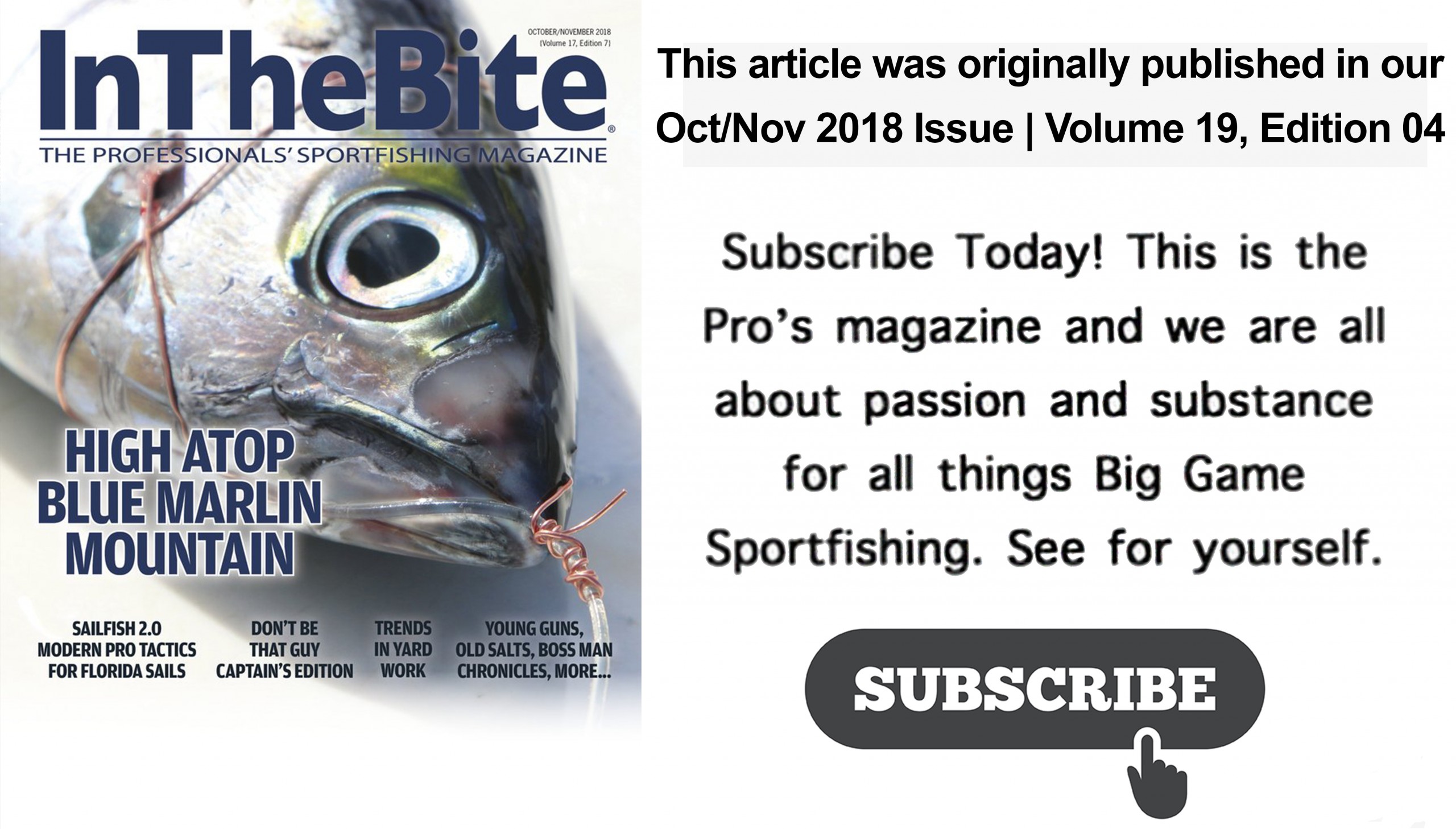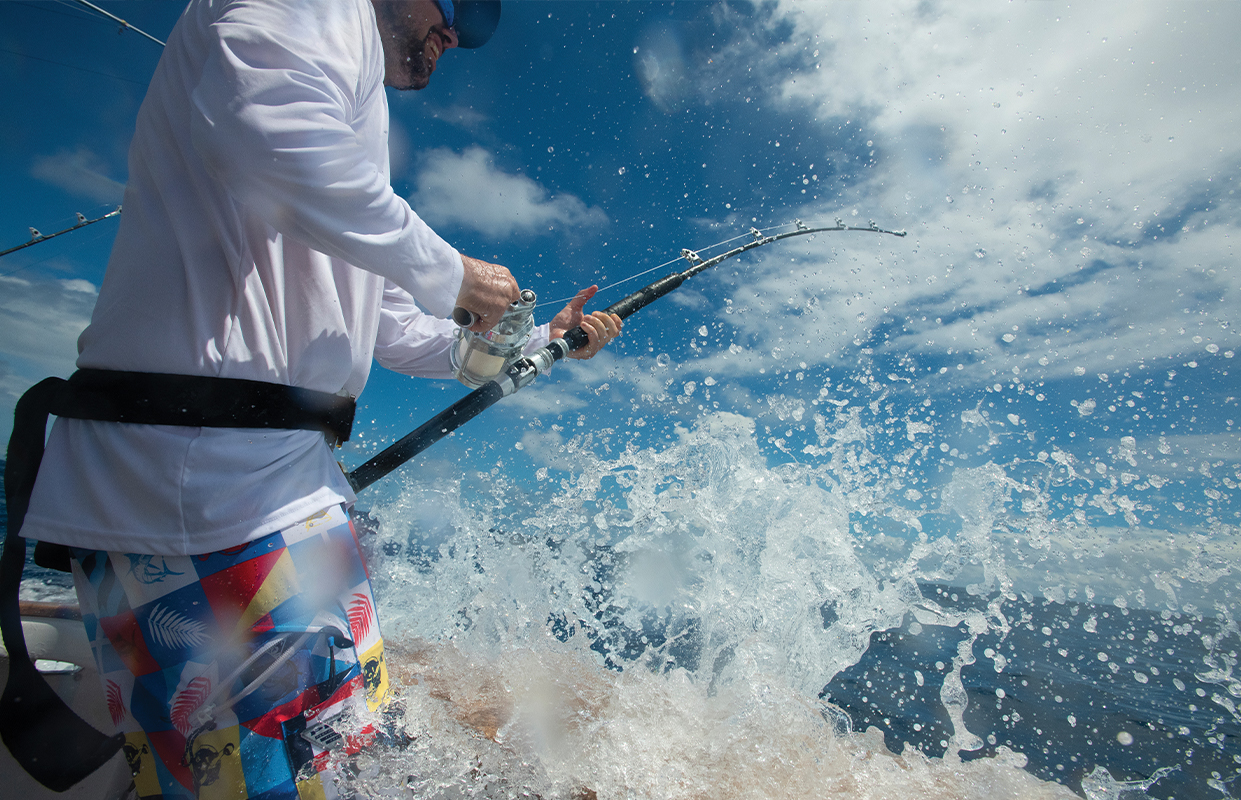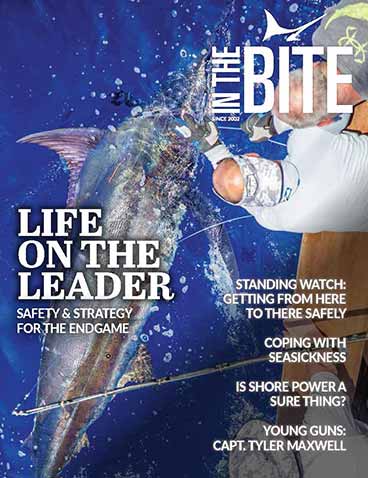sea mount fishery has literally changed the way that people think about marlin fishing. The fishery first developed in a shroud of secrecy as early as 2007 and 2008. Reports of boats seeing 20, 25 or 30 blue marlin in a day started trickling out of Costa Rica in early 2012. It was a time before social media had taken over the world and the way news propagated. The reports coming out of Costa Rica were something of a mystery to all aside from the hand full of people involved. Those hearing of double-digit blue marlin releases at first viewed the news with the combined skepticism of bigfoot sightings and the hopeful optimism of children waiting on the tooth fairy to leave money beneath their pillows¦It sounds like magic, but wouldnt it be great if it were true¦  How influential has Costa Rica sea mount fishery been to the sportfishing landscape? The blue marlin mountains have nothing less than transformed the way we view good blue marlin fishing. Catching ten blue marlin in a day was once the equivalent to bench pressing 900-pounds, running a 3-minute mile, or having dated a Miss Universe¦It was the kind of thing that was theoretically possible, but that was also pretty far removed from anything you might expect to actually to happen to you or anyone you know. The sea mounts have changed this, at least when it comes to catching blue marlin good luck with Miss Universe. Though the origin of the name Costa Rica was attributed to Christopher Columbus (who was describing the amount of gold he believed to be in the country), the name rich coast could just as well be used to describe the nation fisheries. Offshore of the Costa Rican border with Panama is one of the few places in the world where three seismic plates intersect the Nazca Plate, the Cocos Plate and the Caribbean Plate. The seismic activity associated with the boundaries has created sea mounts formed by underwater volcanos. Where these mountains rise from the depths 500 fathoms to 500 feet in some places, provide the setting for some incredible fishing opportunities. In June 2018, Dale Wills and I set out to climb the marlin mountains for ourselves. Host for the trip was Will Drost who owns the Sea Fly, a 43-foot Maverick based out of Los Sueños. Will is also the CFO of Maverick Costa Rica, a sportfishing conglomerate that combines a custom boat building facility with a full-service charter fleet and boat management service. When it comes to understanding the many sides to the sea mount fishery, Will is as well positioned as any one. More on that later. The trip was standard sea mount fare a double overnighter with a full day of fishing sandwiched between days that combined fishing and running to and from the dock. Leaving Los Sueños Marina, the plan was to fish a sea mount 80 miles offshore the first day before fishing another about 130 miles offshore the second day. To cover the distance between the two, we would chug overnight.
How influential has Costa Rica sea mount fishery been to the sportfishing landscape? The blue marlin mountains have nothing less than transformed the way we view good blue marlin fishing. Catching ten blue marlin in a day was once the equivalent to bench pressing 900-pounds, running a 3-minute mile, or having dated a Miss Universe¦It was the kind of thing that was theoretically possible, but that was also pretty far removed from anything you might expect to actually to happen to you or anyone you know. The sea mounts have changed this, at least when it comes to catching blue marlin good luck with Miss Universe. Though the origin of the name Costa Rica was attributed to Christopher Columbus (who was describing the amount of gold he believed to be in the country), the name rich coast could just as well be used to describe the nation fisheries. Offshore of the Costa Rican border with Panama is one of the few places in the world where three seismic plates intersect the Nazca Plate, the Cocos Plate and the Caribbean Plate. The seismic activity associated with the boundaries has created sea mounts formed by underwater volcanos. Where these mountains rise from the depths 500 fathoms to 500 feet in some places, provide the setting for some incredible fishing opportunities. In June 2018, Dale Wills and I set out to climb the marlin mountains for ourselves. Host for the trip was Will Drost who owns the Sea Fly, a 43-foot Maverick based out of Los Sueños. Will is also the CFO of Maverick Costa Rica, a sportfishing conglomerate that combines a custom boat building facility with a full-service charter fleet and boat management service. When it comes to understanding the many sides to the sea mount fishery, Will is as well positioned as any one. More on that later. The trip was standard sea mount fare a double overnighter with a full day of fishing sandwiched between days that combined fishing and running to and from the dock. Leaving Los Sueños Marina, the plan was to fish a sea mount 80 miles offshore the first day before fishing another about 130 miles offshore the second day. To cover the distance between the two, we would chug overnight.  It was a full-service fishing experience. Upon arriving at the first sea mount, we fished until dark. The first day we raised a half dozen blue marlin and induced two bites. One jumped off a lure, the other successfully released. The other fish were lazy a 400 pounder chewed on a teaser, following the boat at four knots for 20 seconds or so without switching. We fished until darkness, had dinner and got some sleep. There is something about fishing offshore as the ocean consumes the last of the sun rays. There is also something about brushing your teeth in the cockpit of half-light and catching five blue marlin before 9:30 in the morning. Day two was wide open. We would catch 11 blues. We raised 27 or so and had more than two dozen bites. The fish were juiced like a bunch of video gamers hopped up on cases of Mountain Dew. None came into the cockpit with us, but three left marks on its hull. The fishing alternated between pulling lures and teasers and live baiting. We were trolling atop a blue marlin buffet. The sea mounts are home to hordes of juvenile yellowfin and bonito. When it right, catching bait is a nonissue. The seething masses of small tuna are a sight to behold. The result is a seemingly endless supply of live bait for the tubes and dead ones for pitch baits and teasers. Captain Carlos Pollo Espinoza and the crew of the Sea Fly drag live baits faster than they do in other places. Rather than bumping in and out gear or keeping it a steady knot or two, we trolled four and a half or so knots when live baiting. The result we covered more ground and found more marlin. If the baits couldnt keep up, no big deal just change them out. Catching them, after all was not a problem. All the bait not only attracts and keeps blue marlin here, it keeps them fat, happy and full of energy. The average fish for us was between 200 and 300 pounds or so, which was perfect for stand up fishing. Most of the fish had bottle rockets inside of them. One left a half inch of bill sticking out the side of the hull. Another two or three hit the boat. One particularly ornery fish left the side plate of the reel hot to the touch. If youd like to see grey hounding, going nuts or crashing around when hooked, there not many better options than scheduling a trip here. With so much food, the fish are ready to put on a show. After a full day of catching blue marlin, we fished until there wasnt any more light. When dinner conversation revolves around trying to remember how many blue marlin you caught, it doesnt matter what the food tastes like. That said, the food was great, the drinks were cold and a day as such is one that changes your worldview. Overnight wed chug to a more shoreward seamount. Wed catch a blue marlin and a dorado early in the morning and run in. We filled then tubes with bait and stopped to grease a yellowfin on the ride in. He was invited to dinner. Our trip 13 blue marlin out of 31 or so raised was perhaps an average sea mount trip. Average 13 blue marlin releases average. If this would have happened in any other place in the world, or any time before 2007, the mayor of the town would have thrown us a parade. In Costa Rica, nobody really batted an eye. If you think about this long enough, with a bit of historical perspective, this really is quite incredible. An average trip was incredible.
It was a full-service fishing experience. Upon arriving at the first sea mount, we fished until dark. The first day we raised a half dozen blue marlin and induced two bites. One jumped off a lure, the other successfully released. The other fish were lazy a 400 pounder chewed on a teaser, following the boat at four knots for 20 seconds or so without switching. We fished until darkness, had dinner and got some sleep. There is something about fishing offshore as the ocean consumes the last of the sun rays. There is also something about brushing your teeth in the cockpit of half-light and catching five blue marlin before 9:30 in the morning. Day two was wide open. We would catch 11 blues. We raised 27 or so and had more than two dozen bites. The fish were juiced like a bunch of video gamers hopped up on cases of Mountain Dew. None came into the cockpit with us, but three left marks on its hull. The fishing alternated between pulling lures and teasers and live baiting. We were trolling atop a blue marlin buffet. The sea mounts are home to hordes of juvenile yellowfin and bonito. When it right, catching bait is a nonissue. The seething masses of small tuna are a sight to behold. The result is a seemingly endless supply of live bait for the tubes and dead ones for pitch baits and teasers. Captain Carlos Pollo Espinoza and the crew of the Sea Fly drag live baits faster than they do in other places. Rather than bumping in and out gear or keeping it a steady knot or two, we trolled four and a half or so knots when live baiting. The result we covered more ground and found more marlin. If the baits couldnt keep up, no big deal just change them out. Catching them, after all was not a problem. All the bait not only attracts and keeps blue marlin here, it keeps them fat, happy and full of energy. The average fish for us was between 200 and 300 pounds or so, which was perfect for stand up fishing. Most of the fish had bottle rockets inside of them. One left a half inch of bill sticking out the side of the hull. Another two or three hit the boat. One particularly ornery fish left the side plate of the reel hot to the touch. If youd like to see grey hounding, going nuts or crashing around when hooked, there not many better options than scheduling a trip here. With so much food, the fish are ready to put on a show. After a full day of catching blue marlin, we fished until there wasnt any more light. When dinner conversation revolves around trying to remember how many blue marlin you caught, it doesnt matter what the food tastes like. That said, the food was great, the drinks were cold and a day as such is one that changes your worldview. Overnight wed chug to a more shoreward seamount. Wed catch a blue marlin and a dorado early in the morning and run in. We filled then tubes with bait and stopped to grease a yellowfin on the ride in. He was invited to dinner. Our trip 13 blue marlin out of 31 or so raised was perhaps an average sea mount trip. Average 13 blue marlin releases average. If this would have happened in any other place in the world, or any time before 2007, the mayor of the town would have thrown us a parade. In Costa Rica, nobody really batted an eye. If you think about this long enough, with a bit of historical perspective, this really is quite incredible. An average trip was incredible.  The realistic opportunity to enjoy consistent double-digit blue marlin days has caused some things to change. Now, in most other places in the world, a good day of blue marlin fishing is qualified, This is no Costa Rica, but¦. The blue marlin mountains have changed the behavior in the fishing tourism market, how boats are built (think fuel capacity and ice makers for overnight trips) and impacted the real estate market in Costa Rica. From concepts philosophical to those more tangible, here is a list of things that the emergence of the Blue Marlin Mountains have transformed in the world of marlin fishing. A Change in Perspective About What Constitutes Good Blue Marlin Fishing Harry Glah owns the Thumper, a 60-foot Mikelson, based out of Golfito. A long time charter operation (www.thumperbluewater.com), Glah provides some perspective on how recent developments have impacted marlin fishing perspective. Weve experienced an incredible increase in numbers of marlin. In the old days, two marlin in a day was great. Now, if we dont catch ten it terrible. Not everyone in the fishing world is a fan of the blue marlin mountains. Charter captains the world over feel the consequences of the changed perspective on a daily basis. With social media reports flooding the internet about 30 blue marlin trips, clients in other places sometimes let these reports influence their expectations. As one longtime Florida charter captain recently told me, Costa Rica has perspectives all out of whack¦. Does it look like were in Costa Rica? Not only do charter captains in other places have to contend with marlin fishing results that are not possible for them, but fishing travel destinations in other locations feel the effects. Tourism departments in other countries are probably not the biggest fans of the blue marlin mountains. If the stated goal of a trip is to catch a bunch of blue marlin, there is a pretty compelling argument that the sea mounts fit the bill directly. This has fundamentally altered consumer behavior in the charter market and how people spend their travel dollars. Just as there are those in other places who are not the biggest fans of the development of the sea mount fishery, those with interest in Costa Real estate or marinas have benefited directly. Access to the world most productive blue marlin fishery has made the appeal of Los Sueños even more universal. Marinas are at full capacity. Many real estate developments with residential units have waiting lists. Those with investments in the country dating to before the sea mounts have largely seen increases in value. Those with more recent purchases may feel secure in the fact that demand for the sea mount fishery shows no signs of dissipating. It is this demand and the relative constancy of good fishing throughout the year that buttresses the perception of risk associated with real estate investment abroad. It is not just those with foreign investment in Costa Rica that benefit from the sea mount fishery. The sea mounts have effectively transformed the fishing calendar. Closing gaps on the booking calendar helps fishing communities and sportfishing operations by providing a more stable client base through the year. This makes possible stable, year-round employment opportunities in the sportfishing space both charter and private operations, as well as the many thousands of jobs made possible in the hotels, restaurants, marinas and other tourism-based enterprises that depend on the money spent by visitors. Prior to the emergence of the sea mount fishery, Costa Rica was largely considered a seasonal fishery. In my first year in Costa Rica, six years ago, there were trips available in July and August, but the charter season came to a halt. There was a stigma about the rainy season in Costa Rica the time to go was February, recalls Will Drost. These days, with the development of the sea mount fishery, July and August are the busiest charter months on the calendar for many operators. How did this come about? Consider the monthly report from the Maverick fleet for August 2018. A fleet of six boats caught: 220 blue marlin, 3 blacks, 3 striped marlin, 132 yellowfin and 115 dolphin. Costa Rica is now a year-round destination, Drost describes. The Costa Rican government embraces tourism and recreational fishing. The government provides good leadership and a strong economic base. It has isolated Costa Rica from the problems occurring in other countries. More than that, the government and the charter industry here understand and embrace conservation. The sea mount season here runs from May through November. Weve had some epic trips around Thanksgiving, Drost says. Charters now have increased double-digit blue marlin days, which attracts more charter clients. There is also a reduced stigma of the rainy season. Now we charter quite a bit more inshore (targeting sailfish) in July and August as well. The sea mount influence has spilled over the inshore fishing is great that time of year. All of this translates to good news for customers. Costa Rica is not as crowded and it might not be as hot as it can be in January and February. Once upon a time video of jumping blue marlin was a limited commodity. These days, in large part due to the sea mount fishery, this is no longer the case. Media outlets and social media feeds are full to the brim jumping blue marlin video and photography. A mere ten years ago this type of jumping fish video was National Geographic territory now everyone has got some. This evolution has happened quickly and is quite interesting to think about. If you are an aspiring wildlife photographer or video person and you want to either get lots of shots at taking great pictures or learn how to do it, a sea mount trip might be in order. Any time something new comes along that fundamentally changes the way people relate with an activity, there are those who are for it and those who are against it. Like baseball purists who still hope to do away with the designated hitter or instant replay, there are those who are unsure about the blue marlin mountains. The usual argument states that the sea mounts provide an unfair advantage, making blue marlin too accessible and too easy to catch. This perspective, in and of itself, provides context for just how good the blue marlin fishing can be on the mountain. There is a certain amount of character building that goes along with searching endless blue expanses, day after day, for one marlin shot every other day. The blue marlin mountains, because they support the fishery that they do, perhaps do not provide this type of hard-earned perspective. People might complain about the sea mount fishery just as people might complain about those steakhouses that offer the 7-pound, free-if-you-can-eat-it-all porterhouse. Sure, people might voice some philosophical differences of opinion the blue marlin are too easy to catch or the steak is too big. What kind of greedy person would want to do either one? For most dissidents, however, all of these philosophical differences disappear with an invitation to give it a shot. Want to try to eat the giant steak tonight? Want to reel in blue marlin until your hands cramp up? Sure, why the hell not? Let do it. Double-digit blue marlin days, much like giant steaks, have a way smoothing out differences of opinion. Here’s another great story from 2017 in the early days of Costa Rica FAD Fishing.
The realistic opportunity to enjoy consistent double-digit blue marlin days has caused some things to change. Now, in most other places in the world, a good day of blue marlin fishing is qualified, This is no Costa Rica, but¦. The blue marlin mountains have changed the behavior in the fishing tourism market, how boats are built (think fuel capacity and ice makers for overnight trips) and impacted the real estate market in Costa Rica. From concepts philosophical to those more tangible, here is a list of things that the emergence of the Blue Marlin Mountains have transformed in the world of marlin fishing. A Change in Perspective About What Constitutes Good Blue Marlin Fishing Harry Glah owns the Thumper, a 60-foot Mikelson, based out of Golfito. A long time charter operation (www.thumperbluewater.com), Glah provides some perspective on how recent developments have impacted marlin fishing perspective. Weve experienced an incredible increase in numbers of marlin. In the old days, two marlin in a day was great. Now, if we dont catch ten it terrible. Not everyone in the fishing world is a fan of the blue marlin mountains. Charter captains the world over feel the consequences of the changed perspective on a daily basis. With social media reports flooding the internet about 30 blue marlin trips, clients in other places sometimes let these reports influence their expectations. As one longtime Florida charter captain recently told me, Costa Rica has perspectives all out of whack¦. Does it look like were in Costa Rica? Not only do charter captains in other places have to contend with marlin fishing results that are not possible for them, but fishing travel destinations in other locations feel the effects. Tourism departments in other countries are probably not the biggest fans of the blue marlin mountains. If the stated goal of a trip is to catch a bunch of blue marlin, there is a pretty compelling argument that the sea mounts fit the bill directly. This has fundamentally altered consumer behavior in the charter market and how people spend their travel dollars. Just as there are those in other places who are not the biggest fans of the development of the sea mount fishery, those with interest in Costa Real estate or marinas have benefited directly. Access to the world most productive blue marlin fishery has made the appeal of Los Sueños even more universal. Marinas are at full capacity. Many real estate developments with residential units have waiting lists. Those with investments in the country dating to before the sea mounts have largely seen increases in value. Those with more recent purchases may feel secure in the fact that demand for the sea mount fishery shows no signs of dissipating. It is this demand and the relative constancy of good fishing throughout the year that buttresses the perception of risk associated with real estate investment abroad. It is not just those with foreign investment in Costa Rica that benefit from the sea mount fishery. The sea mounts have effectively transformed the fishing calendar. Closing gaps on the booking calendar helps fishing communities and sportfishing operations by providing a more stable client base through the year. This makes possible stable, year-round employment opportunities in the sportfishing space both charter and private operations, as well as the many thousands of jobs made possible in the hotels, restaurants, marinas and other tourism-based enterprises that depend on the money spent by visitors. Prior to the emergence of the sea mount fishery, Costa Rica was largely considered a seasonal fishery. In my first year in Costa Rica, six years ago, there were trips available in July and August, but the charter season came to a halt. There was a stigma about the rainy season in Costa Rica the time to go was February, recalls Will Drost. These days, with the development of the sea mount fishery, July and August are the busiest charter months on the calendar for many operators. How did this come about? Consider the monthly report from the Maverick fleet for August 2018. A fleet of six boats caught: 220 blue marlin, 3 blacks, 3 striped marlin, 132 yellowfin and 115 dolphin. Costa Rica is now a year-round destination, Drost describes. The Costa Rican government embraces tourism and recreational fishing. The government provides good leadership and a strong economic base. It has isolated Costa Rica from the problems occurring in other countries. More than that, the government and the charter industry here understand and embrace conservation. The sea mount season here runs from May through November. Weve had some epic trips around Thanksgiving, Drost says. Charters now have increased double-digit blue marlin days, which attracts more charter clients. There is also a reduced stigma of the rainy season. Now we charter quite a bit more inshore (targeting sailfish) in July and August as well. The sea mount influence has spilled over the inshore fishing is great that time of year. All of this translates to good news for customers. Costa Rica is not as crowded and it might not be as hot as it can be in January and February. Once upon a time video of jumping blue marlin was a limited commodity. These days, in large part due to the sea mount fishery, this is no longer the case. Media outlets and social media feeds are full to the brim jumping blue marlin video and photography. A mere ten years ago this type of jumping fish video was National Geographic territory now everyone has got some. This evolution has happened quickly and is quite interesting to think about. If you are an aspiring wildlife photographer or video person and you want to either get lots of shots at taking great pictures or learn how to do it, a sea mount trip might be in order. Any time something new comes along that fundamentally changes the way people relate with an activity, there are those who are for it and those who are against it. Like baseball purists who still hope to do away with the designated hitter or instant replay, there are those who are unsure about the blue marlin mountains. The usual argument states that the sea mounts provide an unfair advantage, making blue marlin too accessible and too easy to catch. This perspective, in and of itself, provides context for just how good the blue marlin fishing can be on the mountain. There is a certain amount of character building that goes along with searching endless blue expanses, day after day, for one marlin shot every other day. The blue marlin mountains, because they support the fishery that they do, perhaps do not provide this type of hard-earned perspective. People might complain about the sea mount fishery just as people might complain about those steakhouses that offer the 7-pound, free-if-you-can-eat-it-all porterhouse. Sure, people might voice some philosophical differences of opinion the blue marlin are too easy to catch or the steak is too big. What kind of greedy person would want to do either one? For most dissidents, however, all of these philosophical differences disappear with an invitation to give it a shot. Want to try to eat the giant steak tonight? Want to reel in blue marlin until your hands cramp up? Sure, why the hell not? Let do it. Double-digit blue marlin days, much like giant steaks, have a way smoothing out differences of opinion. Here’s another great story from 2017 in the early days of Costa Rica FAD Fishing.













